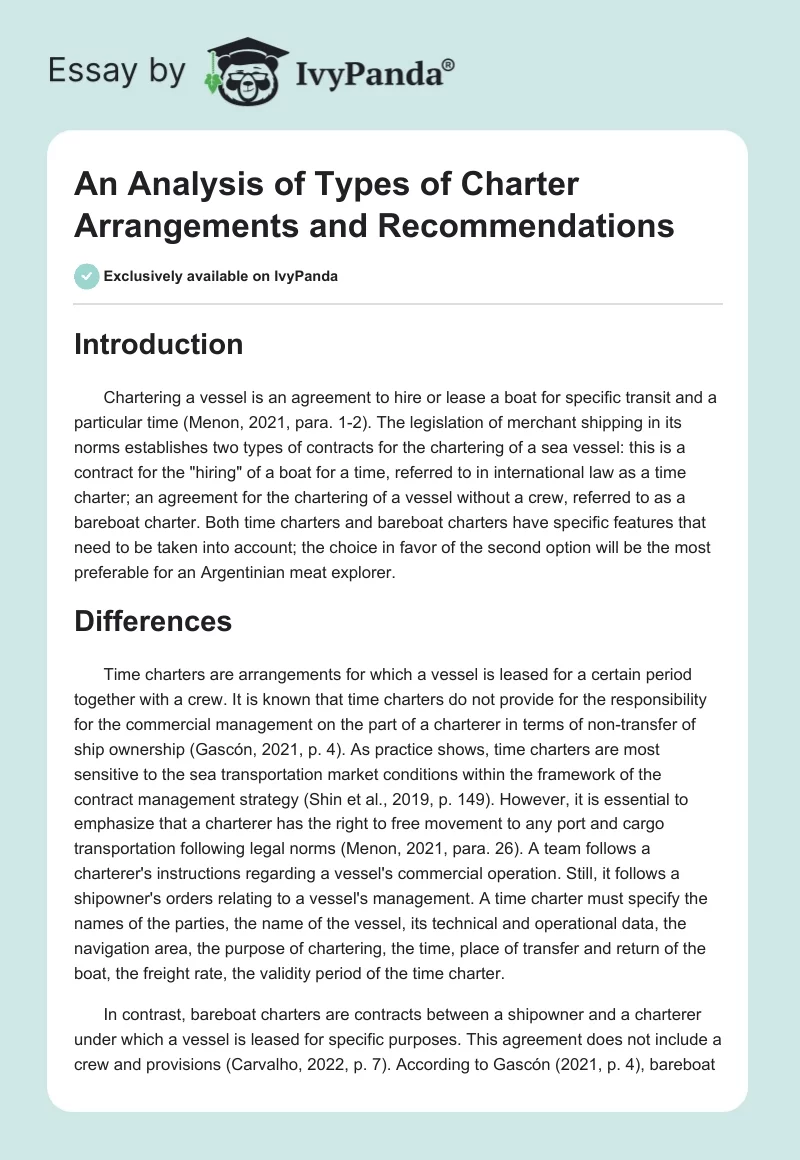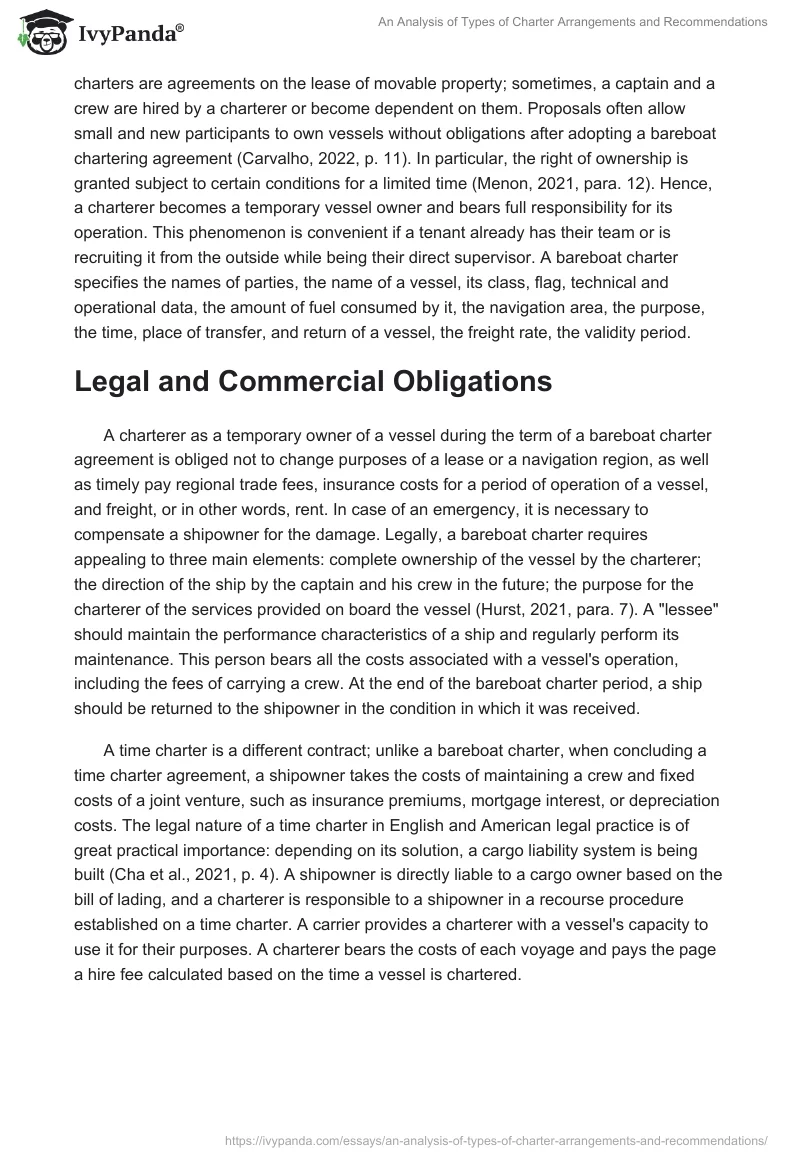Introduction
Chartering a vessel is an agreement to hire or lease a boat for specific transit and a particular time (Menon, 2021, para. 1-2). The legislation of merchant shipping in its norms establishes two types of contracts for the chartering of a sea vessel: this is a contract for the “hiring” of a boat for a time, referred to in international law as a time charter; an agreement for the chartering of a vessel without a crew, referred to as a bareboat charter. Both time charters and bareboat charters have specific features that need to be taken into account; the choice in favor of the second option will be the most preferable for an Argentinian meat explorer.
Differences
Time charters are arrangements for which a vessel is leased for a certain period together with a crew. It is known that time charters do not provide for the responsibility for the commercial management on the part of a charterer in terms of non-transfer of ship ownership (Gascón, 2021, p. 4). As practice shows, time charters are most sensitive to the sea transportation market conditions within the framework of the contract management strategy (Shin et al., 2019, p. 149). However, it is essential to emphasize that a charterer has the right to free movement to any port and cargo transportation following legal norms (Menon, 2021, para. 26). A team follows a charterer’s instructions regarding a vessel’s commercial operation. Still, it follows a shipowner’s orders relating to a vessel’s management. A time charter must specify the names of the parties, the name of the vessel, its technical and operational data, the navigation area, the purpose of chartering, the time, place of transfer and return of the boat, the freight rate, the validity period of the time charter.
In contrast, bareboat charters are contracts between a shipowner and a charterer under which a vessel is leased for specific purposes. This agreement does not include a crew and provisions (Carvalho, 2022, p. 7). According to Gascón (2021, p. 4), bareboat charters are agreements on the lease of movable property; sometimes, a captain and a crew are hired by a charterer or become dependent on them. Proposals often allow small and new participants to own vessels without obligations after adopting a bareboat chartering agreement (Carvalho, 2022, p. 11). In particular, the right of ownership is granted subject to certain conditions for a limited time (Menon, 2021, para. 12). Hence, a charterer becomes a temporary vessel owner and bears full responsibility for its operation. This phenomenon is convenient if a tenant already has their team or is recruiting it from the outside while being their direct supervisor. A bareboat charter specifies the names of parties, the name of a vessel, its class, flag, technical and operational data, the amount of fuel consumed by it, the navigation area, the purpose, the time, place of transfer, and return of a vessel, the freight rate, the validity period.
Legal and Commercial Obligations
A charterer as a temporary owner of a vessel during the term of a bareboat charter agreement is obliged not to change purposes of a lease or a navigation region, as well as timely pay regional trade fees, insurance costs for a period of operation of a vessel, and freight, or in other words, rent. In case of an emergency, it is necessary to compensate a shipowner for the damage. Legally, a bareboat charter requires appealing to three main elements: complete ownership of the vessel by the charterer; the direction of the ship by the captain and his crew in the future; the purpose for the charterer of the services provided on board the vessel (Hurst, 2021, para. 7). A “lessee” should maintain the performance characteristics of a ship and regularly perform its maintenance. This person bears all the costs associated with a vessel’s operation, including the fees of carrying a crew. At the end of the bareboat charter period, a ship should be returned to the shipowner in the condition in which it was received.
A time charter is a different contract; unlike a bareboat charter, when concluding a time charter agreement, a shipowner takes the costs of maintaining a crew and fixed costs of a joint venture, such as insurance premiums, mortgage interest, or depreciation costs. The legal nature of a time charter in English and American legal practice is of great practical importance: depending on its solution, a cargo liability system is being built (Cha et al., 2021, p. 4). A shipowner is directly liable to a cargo owner based on the bill of lading, and a charterer is responsible to a shipowner in a recourse procedure established on a time charter. A carrier provides a charterer with a vessel’s capacity to use it for their purposes. A charterer bears the costs of each voyage and pays the page a hire fee calculated based on the time a vessel is chartered.
A Recommendation
According to the student, choosing a bareboat charter is one of the best solutions for an Argentinian meat explorer. This will make it possible to transport cargo permanently, and management will ultimately fall into the hands of the charterer. Accordingly, this will bring greater efficiency and productivity compared to a time charter, with limited opportunities, since the Argentinian meat explorer needs to supply beef for ten years.
Conclusion
Chartering a vessel is the search for a boat or a place on board a ship for cargo transportation following the tonnage and dimensions of a cargo, in respect of which a client and a transport company subsequently conclude a contract for transportation. A bareboat charter is a contract for chartering a vessel not equipped for sailing and not manned. A time charter implies hiring a ship for a certain period for the transportation of cargo, passengers, or other purposes of merchant shipping and is an independent type of contract. According to the student, a bareboat charter is the best option for an Argentinian meat exporter to transport beef regarding the opportunities and rights provided.
Reference List
Carvalho, F. (2022) Brazilian coastal shipping: new prospects for growth with decarbonization. International Council on Clean Transportation Working Paper 2022-24. Web.
Cha, J. et al. (2021) ‘Legal disputes under time charter in connection with the stranding of the mv ever given. Sustainability, 13(19), 1-25. Web.
Gascón, A.G. (2021) ‘Insurance related problems in bareboat charter agreements’, Journal of Shipping and Trade, 6(1), pp. 1-18. Web.
Hurst, I. (2021) Bareboat charters – what you need to know. Web.
Menon, A. (2021) Voyage charter vs time charter. Web.
Shin, S. H. et al. (2019) ‘Lessons from bankruptcy of Hanjin Shipping Company in chartering’, Maritime Policy & Management, 46(2), pp. 136-155. Web.


